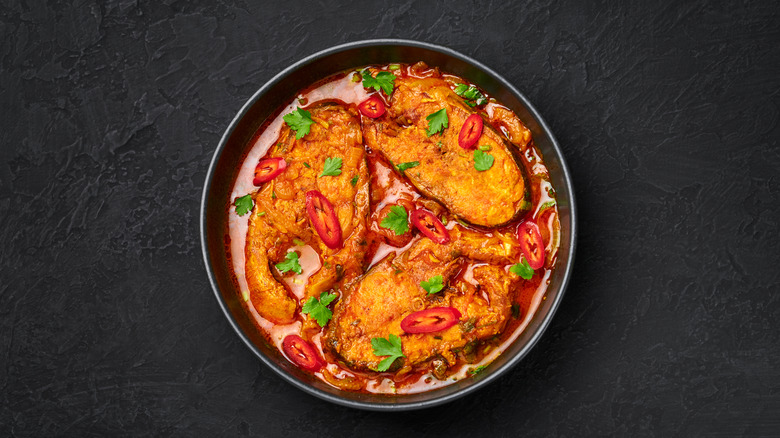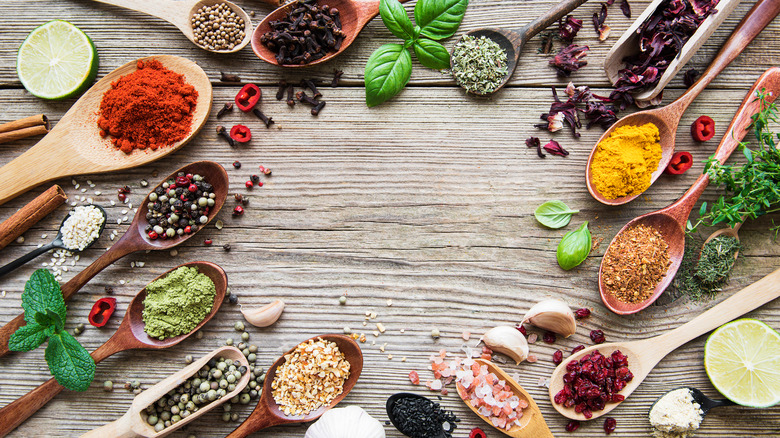How Padma Lakshmi Prepares Fish For Seafood Haters
If you were to ask Padma Lakshmi to name a staple almost certain to be in her kitchen at all times, we'd safely bet she'd say herbs and spices. From sprinkling cinnamon on grapefruit and dusting dried mango powder onto roasted potatoes, to using aromatics like chilies in her deviled eggs and ginger-turmeric syrup in her margarita, it's clear that these rich flavor enhancers are trusty staples in any Lakshmi-approved recipe. After all, the former "Top Chef" host wrote an entire encyclopedia on herbs and spices.
So, does it really come as any surprise that Lakshmi believes the real way to a seafood hater's heart is through a simple fish recipe packed with aromatics?
During an event in New York hosted by Bon Appétit, Lakshmi revealed that, if she had to cook fish for someone who absolutely hated it, she would bring out a whole roster of bold flavors to help it become more palatable. Her go-to's, she said, would include leaning heavily on ginger and makrut lime leaves as well as an array of herbs, and truthfully, that sounds like a combo that could win anyone over.
The science of aromatics and their influence on a dish
Aromatics are essentially one of three things: Vegetables such as shallots, onions, leeks, peppers, carrots, or garlic; spices including chilies, turmeric, cumin, and coriander; or fresh and dried herbs like parsley, chives, oregano, and cilantro, any of which can add both flavor and aroma to food. Each aromatic has a taste profile and scent of its own which, when used in combination with another in the group, can add layers of complex flavor to most dishes and give off an enticing smell.
In this way, it's true that aromatics can indeed play a role in making food taste better. In the case of fish, they may help mask the smell for those who find the aroma of seafood off-putting (on the other hand, who could resist the smell of ginger, garlic, onions, and basil bubbling away in some butter?). And that in turn affects the flavor of the dish, too. As the International Taste Institute explains, flavor is more than just what your taste buds perceive: it's a combination of taste and aroma.
In fact, the Institute points to some theories that claim the aroma of a certain food is responsible for nearly 80% of how we taste it, meaning, an appetizing smell will go a long way in making any food — including fish — taste a whole lot more appetizing too. The key is choosing the right combination to cook with.
These aromatics work best for fish
The most obvious aromatics to choose when cooking fish, especially for a seafood non-believer, are in line with what Lakshmi recommends (in her case, makrut lime leaves and ginger). The bright and citrusy flavor of makrut lime leaves (also called kaffir) is often paired with ginger in Southeast Asian cooking, especially in fish-based recipes. Adding some galangal, chilies, and shallots, or even just lemongrass to the mix could make for an even tastier dish.
Lakshmi has also used mint and ground cumin in combination with ginger, garlic, and onions in her Bali baked fish recipe. While cumin's earthy warmth brings sweet and bitter flavors that are often used to season fish, mint can bring a fresh tang that can cut through all the richness. Herbs like sage, rosemary, dill, parsley, chives, tarragon, basil, and marjoram also pair well with fish, as do spices like smoked paprika and turmeric.
A combination of aromatics like carrots, cilantro, fennel, makrut lime leaves, chilies, shallots, ginger, and curry leaves are featured stars in Lakshmi's mahimahi coconut curry stew recipe whereas ginger, onion, garlic, mango powder, turmeric, green chilies, and curry leaves are her go-to in a Kerala-style meen moilee fish curry. Considering the heavy use of aromatics in Lakshmi's recipes, it would be interesting to consider just how many initial seafood haters she may have converted into enthusiastic fish eaters along the way.



